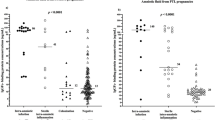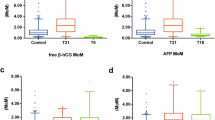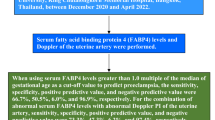Abstract
Objective:
The objective of this study was to evaluate the efficacy of IGFBP-1/AFP (insulin-like growth factor-binding protein-1/alpha-fetoprotein) immunoassay (Amnioquick Duo+) in diagnosing rupture of membranes (ROM).
Study Design:
A prospective, observational study was performed in pregnant women with a history of fluid leakage from the vagina. The IGFBP-1/AFP immunoassay and conventional methods were used to diagnose ROM. The obstetricians were blinded to the results of the IGFBP-1/AFP immunoassay. The diagnosis of ROM was finally confirmed by reviewing the medical records after delivery.
Result:
One hundred patients were recruited into this study. The mean gestational age was 37.6 weeks (range 25 to 41 weeks). Twenty-six percent were preterm and 74% were at term. IGFBP-1/AFP immunoassay had a sensitivity of 94.1%, specificity of 87.5%, positive predictive value of 97.5%, negative predictive value of 73.7% and accuracy of 93% in diagnosing ROM.
Conclusion:
IGFBP-1/AFP immunoassay is a rapid immunoassay test for diagnosing ROM with a high sensitivity and specificity. This test can be used as an alternative method for diagnosis of ROM.
This is a preview of subscription content, access via your institution
Access options
Subscribe to this journal
Receive 12 print issues and online access
$259.00 per year
only $21.58 per issue
Buy this article
- Purchase on Springer Link
- Instant access to full article PDF
Prices may be subject to local taxes which are calculated during checkout

Similar content being viewed by others
References
Phupong V, Taneepanichskul S . Prelabour rupture of membranes. J Paediatr Obstet Gynaecol 2003; 29: 25–32.
ACOG Practice Bulletin No. 80: premature rupture of membranes. Clinical management guidelines for obstetrician-gynecologists. Obstet Gynecol 2007; 109: 1007–1019.
Phupong V, Taneepanichskul S . Outcome of preterm premature rupture of membranes. J Med Assoc Thai 2000; 83: 640–645.
Alexander JM, Cox SM . Clinical course of premature rupture of the membranes. Semin Perinatol 1996; 20: 369–374.
Friedman ML, McElin TW . Diagnosis of ruptured fetal membranes. Clinical study and review of the literature. Am J Obstet Gynecol 1969; 104: 544–550.
Guibourdenche J, Luton D, Andre E, Noel M, Porquet D . Rapid detection of insulin-like growth factor-binding protein-1 and foetal fibronectin in cervico-vaginal secretions to diagnose premature membrane rupture. Ann Clin Biochem 1999; 36: 388–390.
Cousins LM, Smok DP, Lovett SM, Poeltler DM . AmniSure placental alpha microglobulin-1 rapid immunoassay versus standard diagnostic methods for detection of rupture of membranes. Am J Perinatol 2005; 22: 317–320.
Kishida T, Hirao A, Matsuura T, Katamine T, Yamada H, Sagawa T et al. Diagnosis of premature rupture of membranes with an improved alpha-fetoprotein monoclonal antibody kit. Clin Chem 1995; 41: 1500–1503.
Sukchaya K, Phupong V . A comparative study of positive rate of placental alpha-microglobulin-1 test in pre-term pregnant women with and without uterine contraction. J Obstet Gynaecol 2013; 33: 566–568.
Thomasino T, Levi C, Draper M, Neubert AG . Diagnosing rupture of membranes using combination monoclonal/polyclonal immunologic protein detection. J Reprod Med 2013; 58: 187–194.
Jeurgens-Borst AJ, Bekkers RL, Sporken JM, van den Berg PP . Use of insulin like growth factor binding protein-1 in the diagnosis of ruptured fetal membranes. Eur J Obstet Gynecol Reprod Biol 2002; 102: 11–14.
Martinez de Tejada B, Boulvain M, Dumps P, Bischof P, Meisser A, Irion O . Can we improve the diagnosis of rupture of membranes? The value of insulin-like growth factor binding protein-1. BJOG 2006; 113: 1096–1099.
Wang T, Zhou R, Xiong W, Wang Y, Zhu C, Song C et al. Clinical evaluation of soluble intercellular adhesion molecule-1 and insulin like growth factor-binding protein-1-based rapid immunoassays for the diagnosis of prelabor rupture of membranes. J Perinat Med 2013; 41: 181–185.
Tagore S, Kwek K . Comparative analysis of insulin-like growth factor binding protein-1 (IGFBP-1), placental alpha-microglobulin-1 (PAMG-1) and nitrazine test to diagnose premature rupture of membranes in pregnancy. J Perinat Med 2010; 38: 609–612.
Acknowledgements
We wish to thank Dr Thierry Paper, CEO and President of Biosynex SA, France for his kind support and free supply of the Amnioquick Duo+ tests.
Disclaimer
Biosynex SA, which supplied the Amnioquick Duo+ tests, did not get involved or participate in the study design, collection, analysis and manuscript development.
Author information
Authors and Affiliations
Corresponding author
Ethics declarations
Competing interests
The authors declare no conflict of interests.
Rights and permissions
About this article
Cite this article
Ruanphoo, P., Phupong, V. Evaluation of the performance of the insulin-like growth factor-binding protein-1/alpha-fetoprotein test in diagnosing ruptured fetal membranes in pregnant women. J Perinatol 35, 558–560 (2015). https://doi.org/10.1038/jp.2015.6
Received:
Revised:
Accepted:
Published:
Issue Date:
DOI: https://doi.org/10.1038/jp.2015.6
This article is cited by
-
Vaginal Fluid Urea and Creatinine as Indicators of Premature Rupture of Membranes: a Systematic Review
Reproductive Sciences (2021)
-
Diagnostic Accuracy of Insulin-like Growth Factor–Binding Protein-1/alpha-Fetoprotein (AmnioQuick Duo) in Ruptured Fetal Membranes
SN Comprehensive Clinical Medicine (2020)
-
Evaluation of the performance of the insulin-like growth factor-binding protein-1/alpha-fetoprotein test in diagnosing ruptured fetal membranes in pregnant women
Journal of Perinatology (2016)
-
Evaluation of the performance of the insulin-like growth factor-binding protein-1/alpha-fetoprotein test in diagnosing ruptured fetal membranes in pregnant women
Journal of Perinatology (2016)



